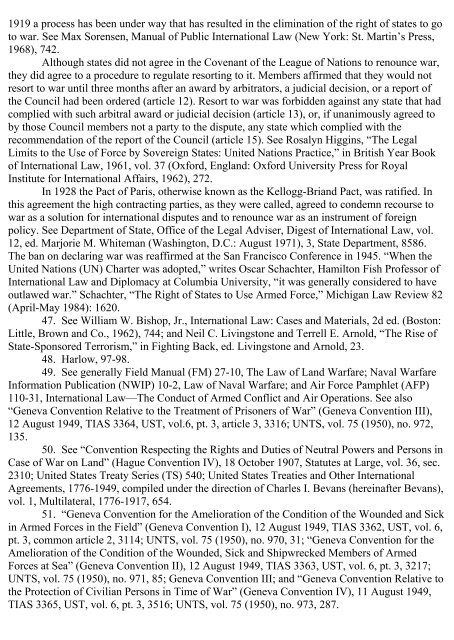Legitimate use of military force against state-sponsored - Air University
Legitimate use of military force against state-sponsored - Air University
Legitimate use of military force against state-sponsored - Air University
Create successful ePaper yourself
Turn your PDF publications into a flip-book with our unique Google optimized e-Paper software.
1919 a process has been under way that has resulted in the elimination <strong>of</strong> the right <strong>of</strong> <strong>state</strong>s to go<br />
to war. See Max Sorensen, Manual <strong>of</strong> Public International Law (New York: St. Martin’s Press,<br />
1968), 742.<br />
Although <strong>state</strong>s did not agree in the Covenant <strong>of</strong> the League <strong>of</strong> Nations to renounce war,<br />
they did agree to a procedure to regulate resorting to it. Members affirmed that they would not<br />
resort to war until three months after an award by arbitrators, a judicial decision, or a report <strong>of</strong><br />
the Council had been ordered (article 12). Resort to war was forbidden <strong>against</strong> any <strong>state</strong> that had<br />
complied with such arbitral award or judicial decision (article 13), or, if unanimously agreed to<br />
by those Council members not a party to the dispute, any <strong>state</strong> which complied with the<br />
recommendation <strong>of</strong> the report <strong>of</strong> the Council (article 15). See Rosalyn Higgins, “The Legal<br />
Limits to the Use <strong>of</strong> Force by Sovereign States: United Nations Practice,” in British Year Book<br />
<strong>of</strong> International Law, 1961, vol. 37 (Oxford, England: Oxford <strong>University</strong> Press for Royal<br />
Institute for International Affairs, 1962), 272.<br />
In 1928 the Pact <strong>of</strong> Paris, otherwise known as the Kellogg-Briand Pact, was ratified. In<br />
this agreement the high contracting parties, as they were called, agreed to condemn recourse to<br />
war as a solution for international disputes and to renounce war as an instrument <strong>of</strong> foreign<br />
policy. See Department <strong>of</strong> State, Office <strong>of</strong> the Legal Adviser, Digest <strong>of</strong> International Law, vol.<br />
12, ed. Marjorie M. Whiteman (Washington, D.C.: August 1971), 3, State Department, 8586.<br />
The ban on declaring war was reaffirmed at the San Francisco Conference in 1945. “When the<br />
United Nations (UN) Charter was adopted,” writes Oscar Schachter, Hamilton Fish Pr<strong>of</strong>essor <strong>of</strong><br />
International Law and Diplomacy at Columbia <strong>University</strong>, “it was generally considered to have<br />
outlawed war.” Schachter, “The Right <strong>of</strong> States to Use Armed Force,” Michigan Law Review 82<br />
(April-May 1984): 1620.<br />
47. See William W. Bishop, Jr., International Law: Cases and Materials, 2d ed. (Boston:<br />
Little, Brown and Co., 1962), 744; and Neil C. Livingstone and Terrell E. Arnold, “The Rise <strong>of</strong><br />
State-Sponsored Terrorism,” in Fighting Back, ed. Livingstone and Arnold, 23.<br />
48. Harlow, 97-98.<br />
49. See generally Field Manual (FM) 27-10, The Law <strong>of</strong> Land Warfare; Naval Warfare<br />
Information Publication (NWIP) 10-2, Law <strong>of</strong> Naval Warfare; and <strong>Air</strong> Force Pamphlet (AFP)<br />
110-31, International Law—The Conduct <strong>of</strong> Armed Conflict and <strong>Air</strong> Operations. See also<br />
“Geneva Convention Relative to the Treatment <strong>of</strong> Prisoners <strong>of</strong> War” (Geneva Convention III),<br />
12 August 1949, TIAS 3364, UST, vol.6, pt. 3, article 3, 3316; UNTS, vol. 75 (1950), no. 972,<br />
135.<br />
50. See “Convention Respecting the Rights and Duties <strong>of</strong> Neutral Powers and Persons in<br />
Case <strong>of</strong> War on Land” (Hague Convention IV), 18 October 1907, Statutes at Large, vol. 36, sec.<br />
2310; United States Treaty Series (TS) 540; United States Treaties and Other International<br />
Agreements, 1776-1949, compiled under the direction <strong>of</strong> Charles I. Bevans (hereinafter Bevans),<br />
vol. 1, Multilateral, 1776-1917, 654.<br />
51. “Geneva Convention for the Amelioration <strong>of</strong> the Condition <strong>of</strong> the Wounded and Sick<br />
in Armed Forces in the Field” (Geneva Convention I), 12 August 1949, TIAS 3362, UST, vol. 6,<br />
pt. 3, common article 2, 3114; UNTS, vol. 75 (1950), no. 970, 31; “Geneva Convention for the<br />
Amelioration <strong>of</strong> the Condition <strong>of</strong> the Wounded, Sick and Shipwrecked Members <strong>of</strong> Armed<br />
Forces at Sea” (Geneva Convention II), 12 August 1949, TIAS 3363, UST, vol. 6, pt. 3, 3217;<br />
UNTS, vol. 75 (1950), no. 971, 85; Geneva Convention III; and “Geneva Convention Relative to<br />
the Protection <strong>of</strong> Civilian Persons in Time <strong>of</strong> War” (Geneva Convention IV), 11 August 1949,<br />
TIAS 3365, UST, vol. 6, pt. 3, 3516; UNTS, vol. 75 (1950), no. 973, 287.
















